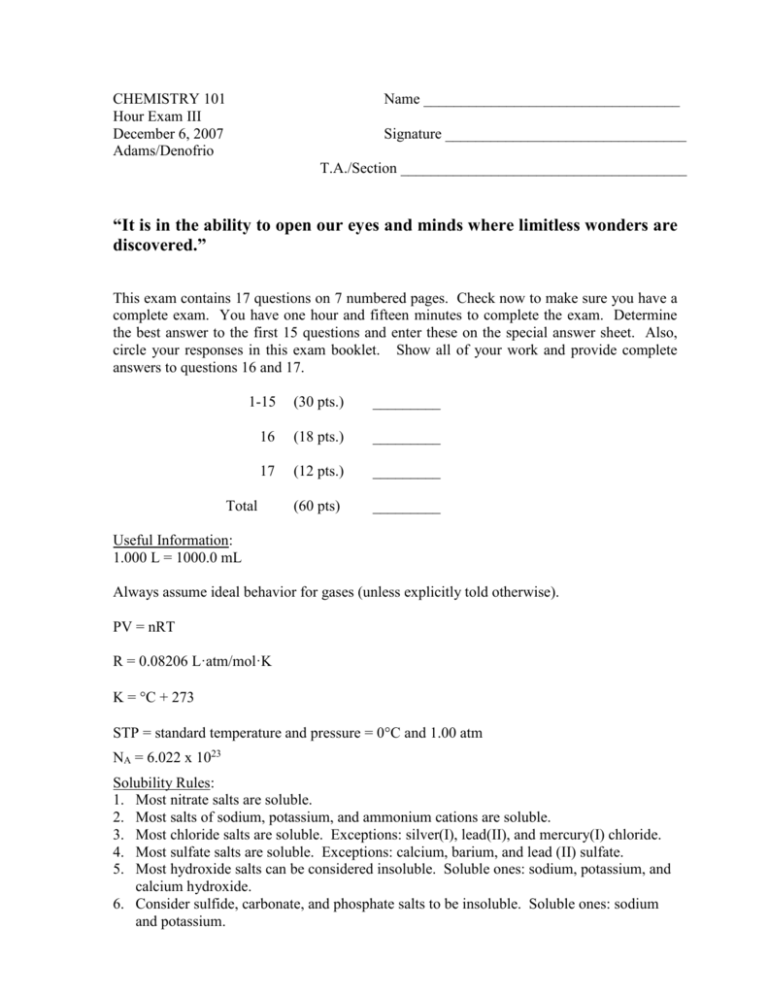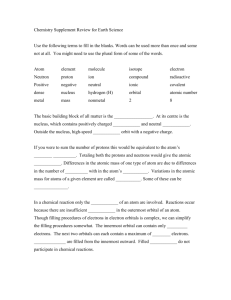Fall 2007 Exam
advertisement

CHEMISTRY 101 Hour Exam III December 6, 2007 Adams/Denofrio Name __________________________________ Signature ________________________________ T.A./Section ______________________________________ “It is in the ability to open our eyes and minds where limitless wonders are discovered.” This exam contains 17 questions on 7 numbered pages. Check now to make sure you have a complete exam. You have one hour and fifteen minutes to complete the exam. Determine the best answer to the first 15 questions and enter these on the special answer sheet. Also, circle your responses in this exam booklet. Show all of your work and provide complete answers to questions 16 and 17. 1-15 (30 pts.) _________ 16 (18 pts.) _________ 17 (12 pts.) _________ (60 pts) _________ Total Useful Information: 1.000 L = 1000.0 mL Always assume ideal behavior for gases (unless explicitly told otherwise). PV = nRT R = 0.08206 L·atm/mol·K K = C + 273 STP = standard temperature and pressure = 0C and 1.00 atm NA = 6.022 x 1023 Solubility Rules: 1. Most nitrate salts are soluble. 2. Most salts of sodium, potassium, and ammonium cations are soluble. 3. Most chloride salts are soluble. Exceptions: silver(I), lead(II), and mercury(I) chloride. 4. Most sulfate salts are soluble. Exceptions: calcium, barium, and lead (II) sulfate. 5. Most hydroxide salts can be considered insoluble. Soluble ones: sodium, potassium, and calcium hydroxide. 6. Consider sulfide, carbonate, and phosphate salts to be insoluble. Soluble ones: sodium and potassium. CHEMISTRY 101 Hour Exam III Fall 2007 Page No. 1 Consider the element sulfur to answer questions 1 – 2. 1. How many unpaired electrons does sulfur contain in its ground state? a) 0 b) 1 c) 2 d) 3 e) 6 2. What is the correct electron configuration for the most stable form of the sulfur ion in an ionic compound? a) b) c) d) e) 1s22s22p6 1s22s22p63s2 1s22s22p63s23p2 1s22s22p63s23p4 1s22s22p63s23p6 ---------------------------------------------------------------------------------------------------------------3. Why does elemental hydrogen exist as a diatomic molecule? Choose the best answer. a) Each hydrogen atom wants to have a 1s2 electron configuration in order to have a filled shell. b) The hydrogen molecule must be more stable (at a lower energy state) than the hydrogen atoms existing separately. c) That is just how the Lewis structure works out. d) The electron-electron repulsion between the separate atoms is so great that an electron is transferred and an ionic bond forms. e) The electronegativities between the two atoms are identical so naturally a single bond forms. 4. How many of the following statements are true? I. Energy can be defined as whatever is required to oppose a natural tendency. II. Quantized energy is a continuous spectrum, like a ramp or the slope of a hill. III. If energy is transferred into a system, the system works to transfer the energy back out. IV. If a process requires activation energy to proceed, the process must be endothermic overall. V. The driving force for a chemical reaction is to achieve a lower energy state. a) 1 b) 2 c) 3 d) 4 e) 5 5. Can an electron in a phosphorus atom ever be in a 3d orbital? Choose the best answer. a) b) c) d) Yes. An electron can be excited into a 3d orbital. Yes. A ground-state electron in phosphorus is located in a 3d orbital. No. Only transition metal atoms can have electrons located in the d orbitals. No. This would not correspond to phosphorus’ electron arrangement in its ground state. e) Both c and d are correct. CHEMISTRY 101 Hour Exam III Fall 2007 Page No. 2 6. Which of the following elements has the largest atomic radius? a) Ca b) Al c) N d) Sr e) F 7. Of the compounds listed below, which has octahedral geometry and is polar overall? a) b) c) d) e) SF6 I3– ICl5 HCl XeF4 8. Of the compounds listed below, which has at least one bond angle that is 90° around the central atom? a) b) c) d) e) H2 ClF3 BF3 CH4 CO2 9. Which of the following bonds most likely resulted from actual electron transfers from one atom to another causing an electrostatic attraction between the two newly formed ions? a) b) c) d) e) O–O N–O Si–O C–O Mg–O 10. Which has a smaller atomic radius, an atom of fluorine or an atom of lithium? Choose the best answer. a) They are the same size because their electrons are contained in the same principle energy level. b) An atom of lithium is smaller than an atom of fluorine because lithium has fewer protons. c) An atom of lithium is smaller than an atom of fluorine because as you add electrons going across a row, the electron shells get further and further from the nucleus. d) An atom of fluorine is smaller than an atom of lithium because with more protons the electrons are pulled closer to the nucleus. e) An atom of fluorine is smaller than an atom of lithium because fluorine has a high ionization energy and will not lose electrons as easily as lithium. CHEMISTRY 101 Hour Exam III Fall 2007 Page No. 3 ---------------------------------------------------------------------------------------------------------------Consider the following processes to answer questions 11 – 12. I. A match burns after it is struck against a matchbox. II. A pot of liquid water boils on the stove. III. A banana freezes after it is submerged in liquid nitrogen. IV. Solid CO2 (dry ice) sublimes into gaseous CO2. 11. Which of the following are exothermic processes? a) b) c) d) e) I, II I, III II, IV I only IV only 12. Choose the energy diagram that best represents process I: A match burns after it is struck against a matchbox. --------------------------------------------------------------------------------------------------------------------- CHEMISTRY 101 Hour Exam III Fall 2007 Page No. 4 Consider the following compounds to answer questions 13 – 15. CO2 N2 CCl4 PBr5 13. How many of the compounds above contain polar covalent bonds? a) 0 b) 1 c) 2 d) 3 e) 4 14. How many of the compounds above are polar overall? a) 0 b) 1 c) 2 d) 3 15. Which compound exhibits resonance? a) b) c) d) e) CO2 N2 CCl4 PBr5 At least two of the above compounds exhibit resonance. e) 4 CHEMISTRY 101 Hour Exam III Fall 2007 Page No. 5 16. The following are true/false questions that require explanation. State whether the underlined statements are “true” or “false” and then provide the requested explanation or support. Please limit your answers to the space provided. True or False? Exciting a sample of neon gas (like we did in lecture) results in the emission of white light. If true, thoroughly explain why white light is observed. If false, provide a thorough explanation. True or False? The hydrogen 1s orbital and the lithium 1s orbital are the same size. If true, explain why. If false, state which 1s orbital should be larger along with an explanation. CHEMISTRY 101 Hour Exam III Fall 2007 Page No. 6 16. cont’d True or False? Lithium, sodium, potassium, and rubidium are considered an isoelectronic series because they all have the same number of valence electrons. If true, rank the atoms in order of increasing ionization energy and justify your answer. If false, explain why and provide an isoelectronic series that contains at least four atoms/ions. Then, rank the atoms/ions in your series in order of increasing ionization energy and justify your answer. CHEMISTRY 101 Hour Exam III Fall 2007 Page No. 7 17. Consider the molecules HF and HCl. a) Which of the two molecules contains a stronger polar bond? Explain your answer. b) For which substance are the dipole-dipole interactions between the molecules stronger? Explain your answer. Be sure to discuss how partial charges (charge separation) play a role. c) Starting with liquid HF and liquid HCl, as we heat these samples at the same rate, which would boil first? Be sure to thoroughly explain your answer.






